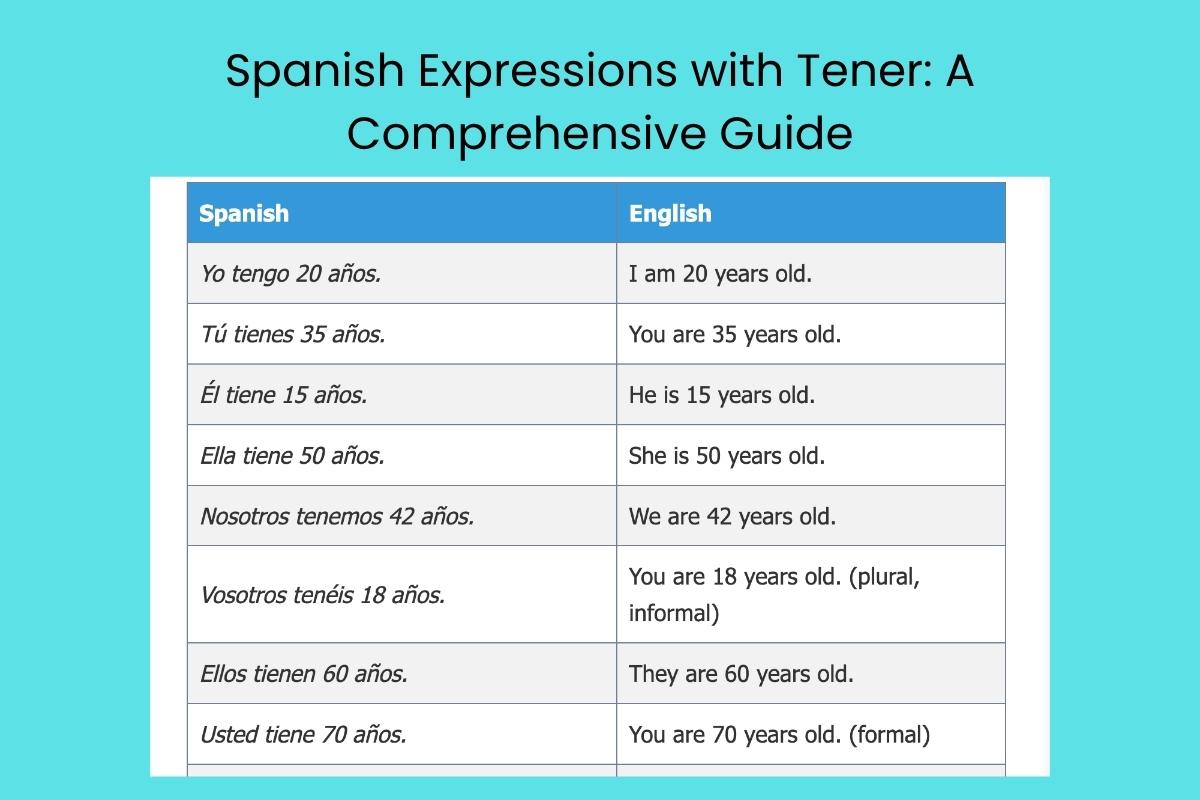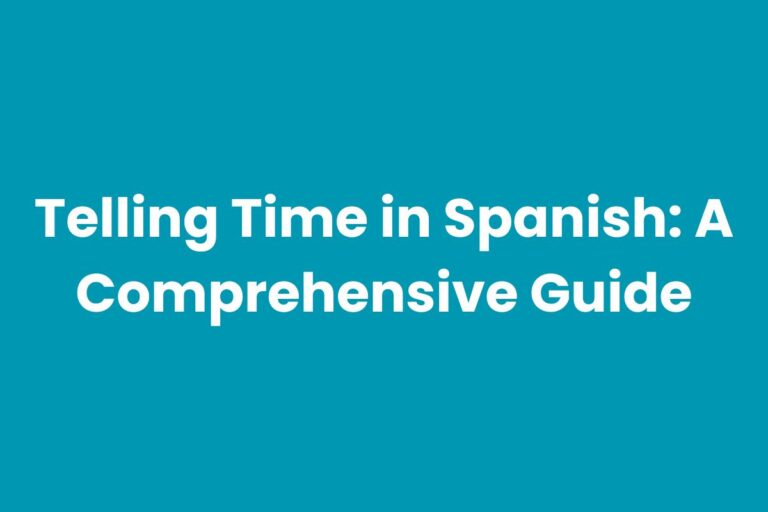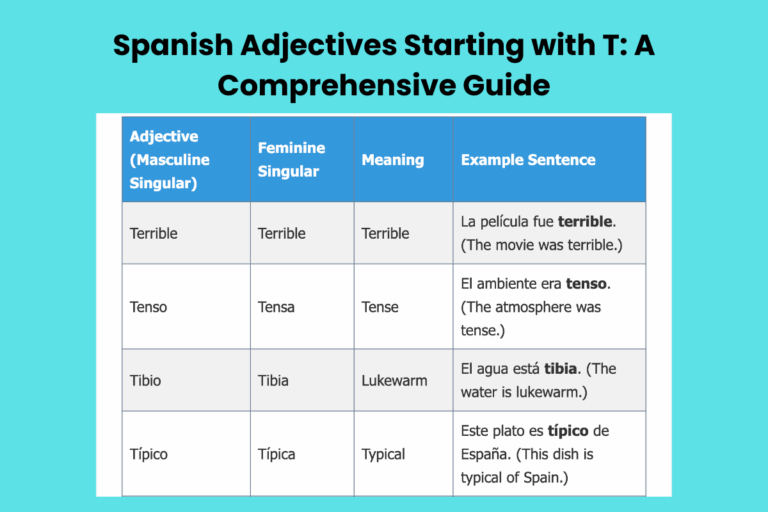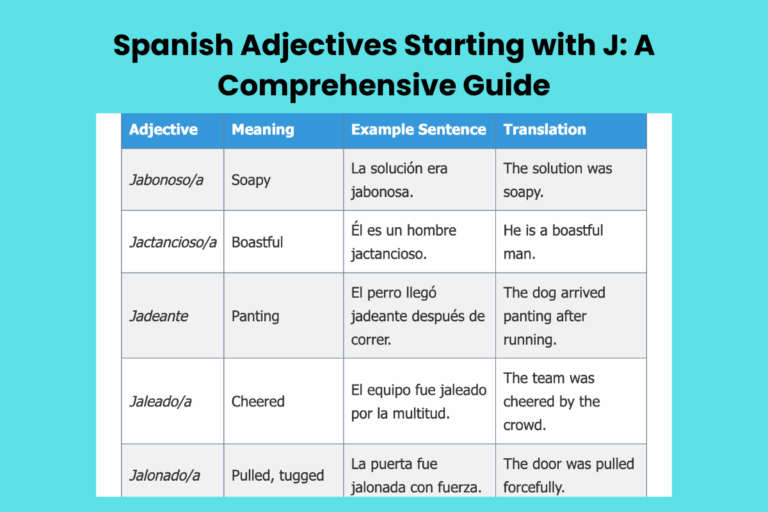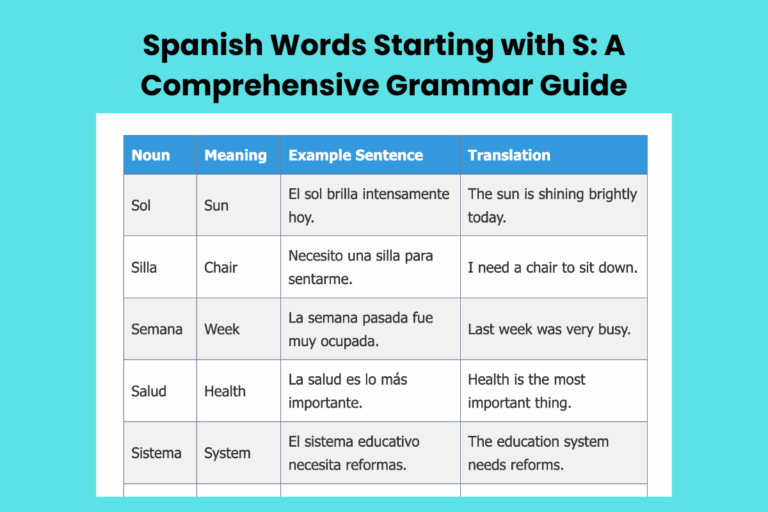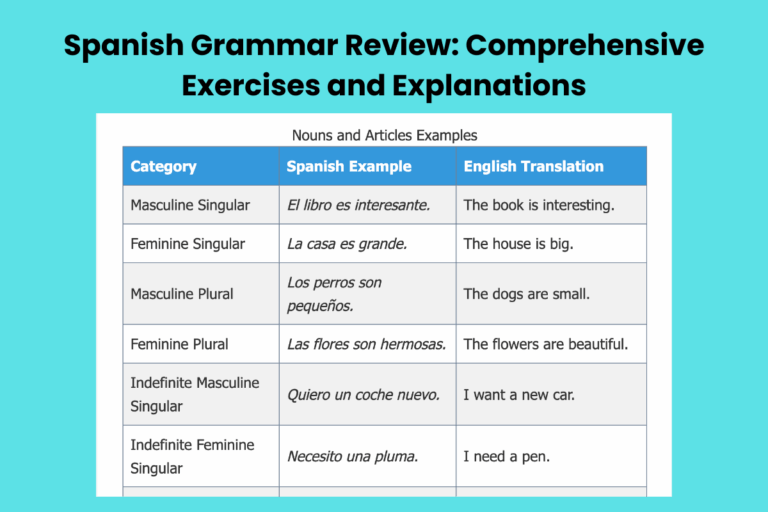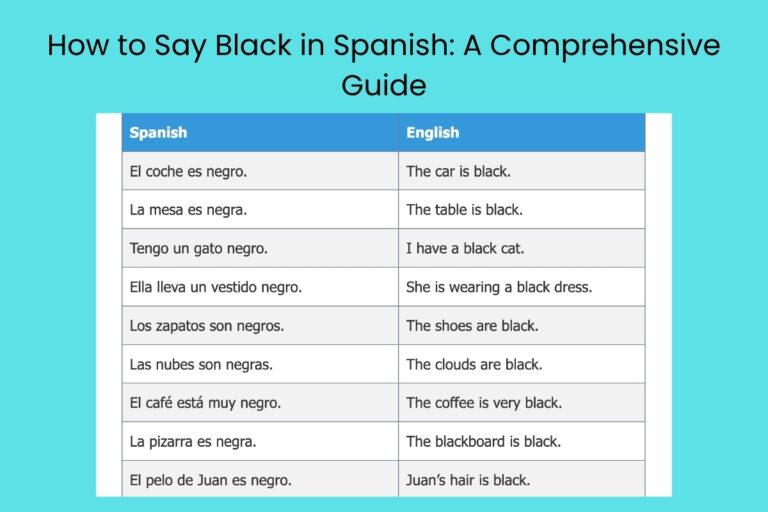Spanish Expressions with Tener: A Comprehensive Guide
Mastering the verb tener (to have) and its idiomatic expressions is crucial for achieving fluency in Spanish. While tener literally means “to have,” it’s also used in a variety of common expressions that don’t directly translate from English. Understanding these expressions will significantly improve your comprehension and ability to communicate naturally in Spanish. This guide is designed for Spanish learners of all levels, from beginners to advanced students, aiming to provide a comprehensive overview of tener expressions, their meanings, and their proper usage.
This article breaks down the complexities of tener expressions, providing detailed explanations, numerous examples, and practical exercises to help you confidently incorporate them into your Spanish vocabulary. By the end of this guide, you’ll have a solid understanding of how to use tener in various contexts, avoiding common mistakes and enhancing your overall language skills.
Table of Contents
- Definition of Tener and its Expressions
- Structural Breakdown
- Types and Categories of Tener Expressions
- Examples of Tener Expressions
- Usage Rules
- Common Mistakes
- Practice Exercises
- Advanced Topics
- FAQ
- Conclusion
Definition of Tener and its Expressions
The verb tener is one of the most fundamental verbs in the Spanish language. Its primary meaning is “to have” or “to possess.” However, tener extends far beyond simple possession and is used in numerous idiomatic expressions that convey different meanings. These expressions often involve feelings, states of being, or obligations, and they are essential for fluent communication in Spanish.
In essence, tener expressions are fixed phrases that use the verb tener in combination with a noun or adjective to express a specific idea. These expressions are not always directly translatable to English, making it crucial to learn them as individual units. Understanding the nuances of these expressions can significantly improve your comprehension of spoken and written Spanish, and allow you to express yourself more naturally.
Structural Breakdown
The basic structure of tener expressions typically involves the verb tener conjugated according to the subject, followed by a noun or adjective. The structure is quite simple, but the meaning derived from the combination is what gives these expressions their unique properties. Here’s a breakdown:
Subject + Tener (conjugated) + Noun/Adjective + (Optional Complement)
For example:
- Yo tengo hambre. (I am hungry.)
- Ella tiene miedo. (She is afraid.)
- Nosotros tenemos que estudiar. (We have to study.)
The conjugation of tener is irregular in the present tense, which is important to remember:
- Yo tengo (I have)
- Tú tienes (You have)
- Él/Ella/Usted tiene (He/She/You (formal) have)
- Nosotros/Nosotras tenemos (We have)
- Vosotros/Vosotras tenéis (You (plural, informal) have)
- Ellos/Ellas/Ustedes tienen (They/You (plural, formal) have)
Understanding the correct conjugation of tener is crucial for forming grammatically correct expressions. Pay close attention to the subject pronoun and ensure that the verb is conjugated accordingly.
Types and Categories of Tener Expressions
Tener expressions can be categorized based on the type of meaning they convey. Here are some of the most common categories:
Tener + Age
In Spanish, age is expressed using tener, not ser (to be) as in English. You literally “have” years.
Structure: Subject + Tener + Number + años
Example: Yo tengo 25 años. (I am 25 years old.)
Tener + Physical Sensations
This category includes expressions related to physical sensations like hunger, thirst, and pain.
Structure: Subject + Tener + Noun (related to sensation)
Examples: Tengo hambre. (I am hungry.) Tengo sed. (I am thirsty.)
Tener + Emotions
Tener is also used to express emotions like fear, happiness, and sadness.
Structure: Subject + Tener + Noun (related to emotion)
Examples: Tengo miedo. (I am afraid.) Tengo sueño. (I am sleepy.)
Tener + Obligations
This category involves expressing obligations or necessities.
Structure: Subject + Tener + que + Infinitive
Example: Tengo que estudiar. (I have to study.)
Other Common Tener Expressions
There are many other idiomatic expressions with tener that don’t fit neatly into the above categories. These include expressions related to luck, success, and other general states.
Examples: Tener razón. (To be right.) Tener éxito. (To be successful.)
Examples of Tener Expressions
Below are several tables with examples of tener expressions categorized by their meaning. Each table provides a variety of examples to help you understand the context and usage of each expression.
Table 1: Tener + Age Examples
This table illustrates the use of tener to express age in Spanish. It’s essential to remember that age is expressed using “tener” and not “ser” as it is in English.
| Spanish | English |
|---|---|
| Yo tengo 20 años. | I am 20 years old. |
| Tú tienes 35 años. | You are 35 years old. |
| Él tiene 15 años. | He is 15 years old. |
| Ella tiene 50 años. | She is 50 years old. |
| Nosotros tenemos 42 años. | We are 42 years old. |
| Vosotros tenéis 18 años. | You are 18 years old. (plural, informal) |
| Ellos tienen 60 años. | They are 60 years old. |
| Usted tiene 70 años. | You are 70 years old. (formal) |
| ¿Cuántos años tienes? | How old are you? (informal) |
| ¿Cuántos años tiene usted? | How old are you? (formal) |
| Mi abuelo tiene 80 años. | My grandfather is 80 years old. |
| Mi hermana tiene 22 años. | My sister is 22 years old. |
| El edificio tiene 100 años. | The building is 100 years old. |
| No tengo muchos años. | I am not very old. |
| Ella tiene casi 30 años. | She is almost 30 years old. |
| Tenemos más de 50 años. | We are over 50 years old. |
| Él tiene menos de 25 años. | He is under 25 years old. |
| Tienen la misma edad. | They are the same age. |
| ¿Cuántos años tiene tu hijo? | How old is your son? |
| Tengo veintitantos años. | I am in my early twenties. |
| Tengo treintaitantos años. | I am in my early thirties. |
| Ella tiene cuarenta y pico años. | She is in her forties. |
| Tenemos cincuenta y tantos años. | We are in our fifties. |
| Él tiene sesenta y pico años. | He is in his sixties. |
| Ella no tiene ni idea de cuántos años tiene. | She has no idea how old she is. |
| No aparenta tener tantos años. | He/She doesn’t look that old. |
| Tengo la edad suficiente para saberlo. | I am old enough to know that. |
Table 2: Tener + Physical Sensations Examples
This table focuses on expressions related to physical sensations. It demonstrates how tener is used to convey feelings like hunger, thirst, sleepiness, and pain.
| Spanish | English |
|---|---|
| Tengo hambre. | I am hungry. |
| Tengo sed. | I am thirsty. |
| Tengo sueño. | I am sleepy. |
| Tengo calor. | I am hot. |
| Tengo frío. | I am cold. |
| Tengo dolor de cabeza. | I have a headache. |
| Tengo dolor de estómago. | I have a stomachache. |
| Tengo tos. | I have a cough. |
| Tengo fiebre. | I have a fever. |
| Tengo escalofríos. | I have chills. |
| Tengo ganas de vomitar. | I feel like vomiting. |
| Tengo mareos. | I feel dizzy. |
| Tengo picazón. | I am itchy. |
| Tengo la garganta irritada. | I have a sore throat. |
| Tengo el brazo roto. | I have a broken arm. |
| Tengo cansancio. | I am tired. |
| Tengo alergia. | I have an allergy. |
| Tengo la presión alta. | I have high blood pressure. |
| Tengo la presión baja. | I have low blood pressure. |
| Tengo un resfriado. | I have a cold. |
| Tengo gripe. | I have the flu. |
| Tengo hambre de ti. | I hunger for you. (Figurative) |
| Tengo antojo de helado. | I’m craving ice cream. |
| Tengo el corazón roto. | I have a broken heart. |
| Tengo los ojos llorosos. | I have watery eyes. |
| Tengo la nariz congestionada. | I have a stuffy nose. |
Table 3: Tener + Emotions Examples
This table showcases expressions that use tener to describe emotions. Understanding these expressions is vital for expressing feelings in Spanish.
| Spanish | English |
|---|---|
| Tengo miedo. | I am afraid. |
| Tengo celos. | I am jealous. |
| Tengo vergüenza. | I am ashamed. |
| Tengo prisa. | I am in a hurry. |
| Tengo cuidado. | I am careful. |
| Tengo esperanza. | I have hope. |
| Tengo confianza. | I have confidence. |
| Tengo curiosidad. | I am curious. |
| Tengo paciencia. | I am patient. |
| Tengo suerte. | I am lucky. |
| Tengo ganas de verte. | I want to see you. (I have the desire to see you.) |
| Tengo ganas de bailar. | I feel like dancing. |
| Tengo envidia. | I am envious. |
| Tengo remordimiento. | I have remorse. |
| Tengo pena. | I feel sorry. |
| Tengo rabia. | I am angry. |
| Tengo admiración. | I have admiration. |
| Tengo frustración. | I am frustrated. |
| Tengo nostalgia. | I am nostalgic. |
| Tengo compasión. | I have compassion. |
| Tengo una corazonada. | I have a hunch. |
| Tengo un buen presentimiento. | I have a good feeling. |
| Tengo un mal presentimiento. | I have a bad feeling. |
| Tengo fe. | I have faith. |
| Tengo un nudo en la garganta. | I have a lump in my throat. |
| Tengo la piel de gallina. | I have goosebumps. |
| Tengo el corazón en un puño. | My heart is in my mouth. |
Table 4: Tener + Obligations Examples
This table demonstrates how to express obligations and necessities using tener que + infinitive. This is a fundamental structure for communicating requirements in Spanish.
| Spanish | English |
|---|---|
| Tengo que estudiar. | I have to study. |
| Tienes que trabajar. | You have to work. |
| Tiene que comer. | He/She has to eat. |
| Tenemos que dormir. | We have to sleep. |
| Tenéis que practicar. | You have to practice. (plural, informal) |
| Tienen que llegar temprano. | They have to arrive early. |
| Tengo que ir al médico. | I have to go to the doctor. |
| Tienes que limpiar tu habitación. | You have to clean your room. |
| Tiene que pagar la cuenta. | He/She has to pay the bill. |
| Tenemos que hacer la tarea. | We have to do the homework. |
| Tenéis que ser puntuales. | You have to be on time. (plural, informal) |
| Tienen que respetar las reglas. | They have to respect the rules. |
| Tengo que aprender español. | I have to learn Spanish. |
| Tienes que hablar más alto. | You have to speak louder. |
| Tiene que escuchar con atención. | He/She has to listen carefully. |
| Tenemos que resolver este problema. | We have to solve this problem. |
| Tenéis que tomar una decisión. | You have to make a decision. (plural, informal) |
| Tienen que pedir permiso. | They have to ask for permission. |
| Tengo que terminar este trabajo. | I have to finish this work. |
| Tienes que tener paciencia. | You have to be patient. |
| Tengo que levantarme temprano mañana. | I have to get up early tomorrow. |
| Tienes que irte ya. | You have to leave now. |
| Tiene que pensarlo bien. | He/She has to think it over carefully. |
| Tenemos que ahorrar dinero. | We have to save money. |
| Tenéis que ser más responsables. | You have to be more responsible. (plural, informal) |
| Tienen que disculparse. | They have to apologize. |
Table 5: Other Common Tener Expressions Examples
This table presents a variety of other common idiomatic expressions using tener. These expressions cover a range of meanings and are essential for understanding everyday Spanish conversations.
| Spanish | English |
|---|---|
| Tener razón. | To be right. |
| Tener éxito. | To be successful. |
| Tener cuidado. | To be careful. |
| Tener en cuenta. | To take into account. |
| Tener lugar. | To take place. |
| Tener que ver con. | To have to do with. |
| Tener la culpa. | To be to blame. |
| Tener sentido. | To make sense. |
| Tener presente. | To keep in mind. |
| Tener vergüenza. | To be ashamed. |
| Tener buena pinta. | To look good (food/appearance). |
| Tener mala pinta. | To look bad (food/appearance). |
| Tener labia. | To be a smooth talker. |
| Tener mano izquierda. | To be tactful. |
| Tener pelos en la lengua. | To not mince words. |
| Tener agallas. | To have guts. |
| Tener don de gentes. | To have people skills. |
| Tener la sartén por el mango. | To be in control of the situation. |
| Tener palabra. | To be true to one’s word. |
| Tener enchufe. | To have connections. |
| Tener la mosca detrás de la oreja. | To be suspicious. |
| Tener un humor de perros. | To be in a bad mood. |
| Tener vista de lince. | To have sharp eyesight. |
| Tener memoria de elefante. | To have a great memory. |
| Tener sangre fría. | To be cold-blooded. |
| Tener los pies en la tierra. | To be down to earth. |
Usage Rules
When using tener expressions, it’s essential to follow certain rules to ensure correct grammar and meaning:
- Conjugation: Always conjugate tener according to the subject of the sentence.
- Gender and Number Agreement: When used with nouns, ensure that the noun agrees in gender and number with any articles or adjectives.
- Prepositions: Pay attention to the prepositions used in specific expressions. For example, tener que requires the preposition que before the infinitive.
- Context: Consider the context of the conversation or writing. Some expressions may have different meanings depending on the situation.
Exceptions and Special Cases:
- Some expressions, like tener razón, do not change based on the subject’s gender.
- In certain regions, variations in usage may exist, so it’s helpful to be aware of regional differences.
Common Mistakes
Here are some common mistakes to avoid when using tener expressions:
- Using ser instead of tener for age: Incorrect: Yo soy 20 años. Correct: Yo tengo 20 años.
- Incorrect conjugation of tener: Incorrect: Yo tienes hambre. Correct: Yo tengo hambre.
- Literal translation from English: Avoid translating expressions word-for-word. Tener expressions often have idiomatic meanings that differ from their literal translations.
Examples of Correct vs. Incorrect Usage:
| Incorrect | Correct | Explanation |
|---|---|---|
| Soy hambre. | Tengo hambre. | Use tener, not ser, to express hunger. |
| Él es razón. | Él tiene razón. | Use tener with razón to mean “to be right.” |
| Nosotros somos que estudiar. | Nosotros tenemos que estudiar. | Use tener que to express obligation. |
Practice Exercises
Test your knowledge of tener expressions with these practice exercises. Each exercise focuses on a different aspect of tener usage.
Exercise 1: Fill in the Blanks
Complete the following sentences with the correct form of tener and the appropriate expression.
| Question | Answer |
|---|---|
| 1. Yo ________ 25 años. | Tengo |
| 2. ¿Tú ________ sed? | Tienes |
| 3. Ella ________ que trabajar. | Tiene |
| 4. Nosotros ________ frío. | Tenemos |
| 5. Ellos ________ miedo. | Tienen |
| 6. Usted ________ razón. | Tiene |
| 7. Yo ________ ganas de viajar. | Tengo |
| 8. ¿Cuántos años ________ tú? | Tienes |
| 9. Él ________ dolor de cabeza. | Tiene |
| 10. Nosotros ________ prisa. | Tenemos |
Exercise 2: Translate the Sentences
Translate the following sentences from English to Spanish using tener expressions.
| English | Spanish |
|---|---|
| 1. I am hungry. | Tengo hambre. |
| 2. She is 30 years old. | Ella tiene 30 años. |
| 3. We have to study. | Tenemos que estudiar. |
| 4. They are afraid. | Tienen miedo. |
| 5. You are right. | Tienes razón. (informal) / Usted tiene razón. (formal) |
| 6. I am cold. | Tengo frío. |
| 7. He is thirsty. | Él tiene sed. |
| 8. We are in a hurry. | Tenemos prisa. |
| 9. She has a headache. | Ella tiene dolor de cabeza. |
| 10. I want to see you. | Tengo ganas de verte. |
Exercise 3: Multiple Choice
Choose the correct tener expression to complete each sentence.
| Question | Options | Answer |
|---|---|---|
| 1. Yo ________ mucho sueño. | a) soy b) tengo c) estoy | b) tengo |
| 2. ¿________ tú que irte ahora? | a) Eres b) Tienes c) Estás | b) Tienes |
| 3. Ella ________ suerte en el juego. | a) es b) tiene c) está | b) tiene |
| 4. Nosotros ________ calor. | a) somos b) tenemos c) estamos | b) tenemos |
| 5. Ellos ________ razón en este caso. | a) son b) tienen c) están | b) tienen |
Advanced Topics
For advanced learners, exploring more complex aspects of tener expressions can further enhance your understanding and fluency.
- Subjunctive Mood: Understanding when to use the subjunctive mood with tener expressions, particularly in dependent clauses.
- Regional Variations: Exploring regional differences in the usage of tener expressions.
- Literary Usage: Analyzing how tener expressions are used in literature and poetry to convey deeper meanings.
Example of Subjunctive Use:
Es importante que tengas cuidado. (It’s important that you are careful.) In this sentence, tengas is in the subjunctive mood because it is used in a dependent clause expressing importance.
FAQ
Here are some frequently asked questions about tener expressions:
- Why is tener used for age instead of ser?
In Spanish, age is viewed as something you “have” accumulated over time, rather than a permanent characteristic. Therefore, tener is used to express age, while ser is used for more permanent attributes.
- How can I remember all these tener expressions?
Practice is key! Use flashcards, create example sentences, and try to incorporate these expressions into your daily conversations. The more you use them, the easier they will become to remember.
- Are there any expressions where ser and tener can be used interchangeably?
No, ser and tener generally cannot be used interchangeably in idiomatic expressions. They have distinct meanings and usages. Using the wrong verb can change the meaning of the sentence or make it grammatically incorrect.
- What’s the difference between tener ganas de and querer?
Both tener ganas de and querer can express desire, but tener ganas de often implies a more spontaneous or emotional desire, while querer can be more direct and intentional. For example, “Tengo ganas de verte” (I feel like seeing you) versus “Quiero verte” (I want to see you).
- How do I know when to use tener que + infinitive?
Use tener que + infinitive when you want to express an obligation or necessity. It indicates that someone “has to” do something.
- Is it always necessary to include the subject pronoun with tener expressions?
No, it’s not always necessary. In Spanish, the subject pronoun can be omitted if the verb conjugation makes it clear who the subject is. However, including the pronoun can sometimes add emphasis or clarity.
- Are there regional variations in the use of tener expressions?
Yes, there can be regional variations in the use of some tener expressions. While the core meanings remain consistent, some expressions may be more common in certain regions than others.
- What is the difference between “tener celos” and “estar celoso”?
“Tener celos” (to have jealousy) refers to the feeling or emotion of jealousy itself. “Estar celoso” (to be jealous) describes the state of being jealous at a particular moment. While they are often used interchangeably, “tener celos” describes the inherent feeling, while “estar celoso” describes a temporary state influenced by circumstances.
- How
can I improve my pronunciation of tener in different expressions?
Listen to native Spanish speakers using these expressions and try to imitate their pronunciation. Pay attention to the rhythm and intonation of the language. You can also use online resources and language learning apps to practice pronunciation.
Conclusion
Mastering tener expressions is an essential step in becoming proficient in Spanish. By understanding the various categories, usage rules, and common mistakes associated with these expressions, you can significantly improve your comprehension and fluency. Remember to practice regularly, use these expressions in context, and don’t be afraid to make mistakes – they are a natural part of the learning process.
Continue to explore and expand your knowledge of Spanish idiomatic expressions to enrich your language skills and communicate more effectively with native speakers. ¡Buena suerte!

